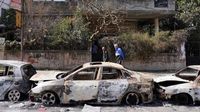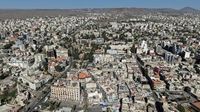War crimes and gross human rights violations have likely been committed by both Syria’s interim government forces and fighters loyal to the country’s ousted regime, according to a damning United Nations report released on August 14, 2025. The report, compiled by the U.N. Syria Commission of Inquiry, details a wave of sectarian violence in March that left approximately 1,400 people dead—most of them civilians from the Alawite community—in a series of massacres along Syria’s coastal areas.
The 56-page report, as cited by Reuters and the BBC, is based on more than 200 interviews with victims and witnesses and includes evidence gathered from three mass grave sites. The commission documented murder, torture, abductions, and inhumane acts related to the treatment of the dead. According to Paulo Sérgio Pinheiro, chair of the U.N. Syria Commission of Inquiry, "The scale and brutality of the violence documented in our report is deeply disturbing."
The violence, which erupted just months after the fall of President Bashar al-Assad in December 2024, primarily targeted Alawites—a minority sect that had long been associated with the Assad regime. Most victims were Alawite men aged between 20 and 50, though women and children as young as one were also killed. In many cases, perpetrators went door to door asking civilians if they were Alawite before taking men and boys away to be executed. Some of these executions were filmed by the killers themselves, a chilling detail that underscores the systematic and calculated nature of the attacks.
The U.N. report found that the violence was not random or isolated, but rather represented a consistent pattern of targeted attacks against civilians. "Acts that likely amount to crimes, including war crimes, were committed by interim government force members as well as fighters linked to the Assad regime," the commission concluded. The violence, which unfolded in Latakia, Tartus, Homs, and Hama governorates—regions with significant Alawite populations—was described as the worst to hit Syria since Assad’s ouster.
According to the BBC, the violence began after security forces loyal to the new interim government were ambushed by groups still loyal to the former regime. The clashes quickly escalated into revenge killings of a sectarian nature, with fighters from both sides—largely Sunni Muslim government forces and mostly Alawite Assad loyalists—participating in the bloodshed. The interim authorities responded by sending reinforcements, and thousands of fighters, including foreigners, joined government ranks to confront the loyalists. The operation spiraled out of control, resulting in house raids, mass executions, and widespread terror.
Hospitals in the affected areas were quickly overwhelmed as bodies piled up. Families, fearing reprisals, were often forced to keep the bodies of their loved ones inside their homes or in the streets for days before they could be buried in mass graves. The humanitarian fallout was immense: thousands of survivors and Alawites fled to neighboring Lebanon or sought refuge at a Russian airbase, while many others relocated to different parts of Syria or abroad.
The U.N. commission emphasized that the violence was not only brutal but also systematic. The report noted, "The consistent patterns of targeted violence against civilians indicate that such acts were not random or isolated." The commission’s investigators gained access to affected communities along the coast, allowing them to document gross human rights violations in 16 locations across Latakia, Tartus, Homs, and Hama.
The violence exposed deep fractures within Syrian society, particularly after the end of Assad’s 14-year rule. Decades of brutality under the Assads had left many Sunnis associating the Alawite minority with the old regime, fueling retributive attacks. The security vacuum following Assad’s ouster, combined with disinformation and hate speech targeting Alawites, further contributed to the escalation of violence. The commission found that after clashes between former and pro-government factions intensified, other fighters—including foreigners—joined the fray, exacerbating the situation.
In response to the massacres, the interim government, led by former rebel Ahmed al-Sharaa, appointed a fact-finding committee and launched an internal inquiry. The government established curfews and checkpoints in some cities, notably sparing Tartus from the worst of the violence. According to the U.N. report, a government inquiry published in July identified 298 alleged perpetrators among military factions and 265 linked to former government fighters. By June 2025, 42 people had been arrested for alleged abuses, and a complaints office was created to handle misconduct cases involving security and police personnel.
Foreign Minister Asaad Hassan al-Shibani, in a letter responding to the U.N. report, stated, "The Syrian Arab Republic values these efforts and reaffirms its commitment to incorporating the recommendations into the ongoing process of institution-building and the consolidation of the rule of law in the new Syria." The government has also pledged to fully investigate any allegations of atrocities committed by all sides. U.S. Special Envoy for Syria Tom Barrack welcomed the U.N. report as a "serious step" toward assessing responsibility for violations.
The U.N. commission’s recommendations are far-reaching. It called on the Syrian government to strengthen its courts system to ensure justice, work on reparations for survivors, and build trust with affected communities. The commission also warned that retaliatory attacks continue "amidst a heightened climate of fear and must urgently be addressed by the interim government." Guarantees of non-repetition of violations, the report stressed, should be at the heart of Syria’s transition.
Meanwhile, sectarian violence has continued to flare elsewhere in Syria since March. In Suweida, in the country’s south, hundreds were reported killed in clashes involving Bedouin and Druze fighters as well as the Syrian army. The government has acknowledged reports of "shocking violations" by individuals wearing military fatigues and has reiterated its commitment to investigating all allegations of atrocities.
The U.N. report, however, is not exhaustive; investigations into incidents in Homs, Latakia, and Tartus are ongoing. Both the Syrian interim government and the international community face a daunting challenge: to address the deep wounds left by years of civil war and to ensure that those responsible for atrocities are held to account. The coming months will test whether Syria’s new leaders can deliver on their promises of justice and reconciliation—or whether the cycle of violence will continue to haunt the country’s fragile peace.


